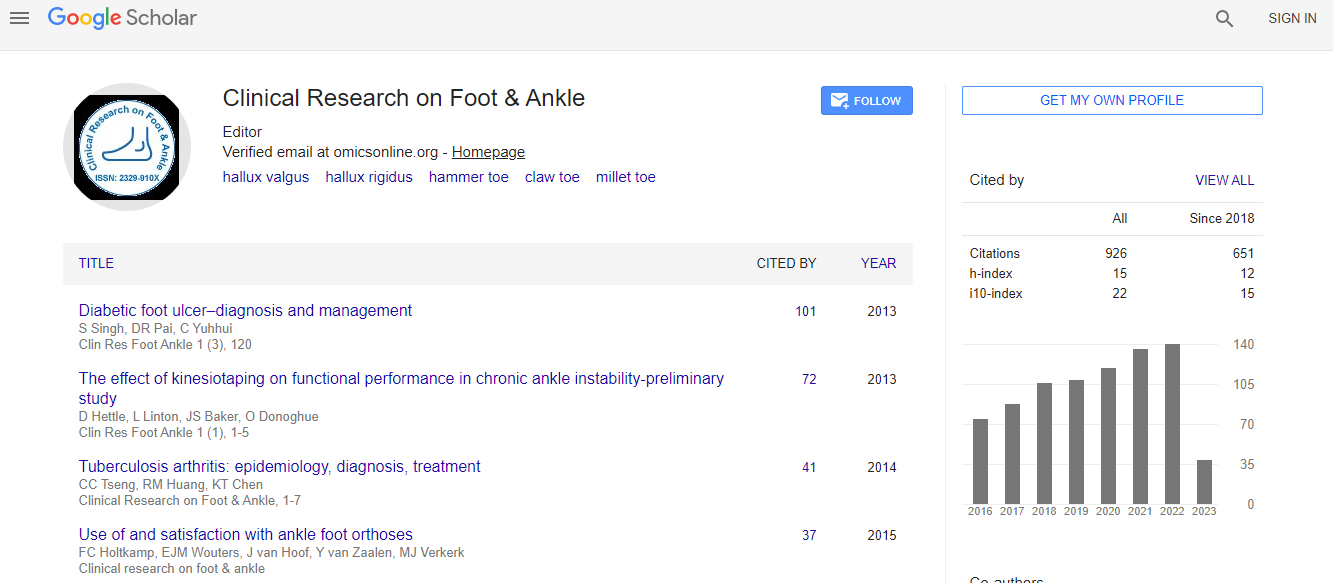Research Article
Indicators of Future Ulceration in Diabetes Patients of Low-Moderate Foot Risk
| Davida Louise O’Brien1, Claire M. Buckley2*, Frank Hill2, Maria Horgan3, Ivan J. Perry2 and Magdalena Tyndyk1 | ||
| 1Medical Engineering, Design and Innovation Centre, Department of Manufacturing, Biomedical and Facilities Engineering, Cork Institute of Technology, Cork, Ireland | ||
| 2Department of Epidemiology and Public Health, University College Cork, Cork, Ireland | ||
| 3Diabetes in General Practice (DiGP) , Department of General Practice, University College Cork, Cork, Ireland | ||
| Corresponding Author : | Claire M Buckley Department of General Practice University College Cork, Cork, Ireland Tel: 00353866020313 E-mail: Claire. buckley@ucc.ie |
|
| Received September 30, 2014; Accepted October 10, 2014; Published October 17, 2014 | ||
| Citation: O’Brien DL, Buckley CM, Hill F, Horgan M, Perry IJ, et al. (2014) Indicators of Future Ulceration in Diabetes Patients of LowModerate Foot Risk. Clin Res Foot Ankle 2:155. doi:10.4172/2329-910X.1000155 | ||
| Copyright: © 2014 Lousie O’Brien, et al. This is an open-access article distributed under the terms of the Creative Commons Attribution License, which permits unrestricted use, distribution, and reproduction in any medium, provided the original author and source are credited. | ||
Related article at Pubmed Pubmed  Scholar Google Scholar Google |
||
Abstract
Background & Aim: Diabetes Mellitus can cause serious health problems including foot complications. Peripheral neuropathy affects the outer appendages, most commonly the lower limbs. Ulceration of the feet has a high possibility of advancement to amputation; thus greatly diminishing quality of life. This study investigates if patients with diabetes, who are at low-moderate risk of foot disease, have any underlying biomechanical signs which may indicate that they are at risk of future ulceration.
Methods: Twenty patients with Diabetes Mellitus at low-moderate risk of foot disease and 32 healthy individuals participated in this study. All participants completed a self-administrated questionnaire (assessing sociodemographic and lifestyle factors) and underwent a clinical foot screening examination (plantar sensation, pedal pulses and ankle range of motion), gait assessment (spatio-temporal parameters) and barefoot plantar pressure analysis. Results between the 2 groups were compared.
Results: Major differences were observed in area of plantar pressure distribution, walking speed and foot alignment between low-moderate risk participants with diabetes and healthy controls. Low-moderate risk participants with diabetes recorded elevated dynamic plantar pressure in regions of metatarsal heads and the heel. Plantar pressure was correlated with arch type and foot alignment (p<0.05). Dissimilarities were not observed for lifestyle behavior and ankle range of motion.
Conclusion: This pilot study demonstrated a group of patients with diabetes at low-moderate risk of foot disease showing significant differences in biomechanical measures that are linked to callus/ulcer formation. Risk factors for ulceration previously reported for high risk patients with diabetes also affect patients with low-moderate foot risk.

 Spanish
Spanish  Chinese
Chinese  Russian
Russian  German
German  French
French  Japanese
Japanese  Portuguese
Portuguese  Hindi
Hindi 
